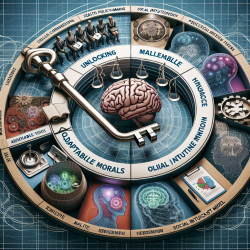Introduction
The realm of autism spectrum disorders (ASDs) is vast and complex, with genetic research offering a beacon of hope in unraveling its intricacies. The article "Autism genetics: searching for specificity and convergence" by Berg and Geschwind (2012) provides a comprehensive overview of the genetic underpinnings of ASDs, emphasizing the importance of identifying convergent pathways for effective therapeutic interventions. This blog aims to translate these insights into practical strategies for practitioners, enhancing their ability to deliver data-driven, impactful therapy to children with ASDs.
Understanding the Genetic Landscape of ASDs
ASDs encompass a range of neuropsychiatric disorders characterized by deficits in social communication, language development, and restrictive, repetitive behaviors. The genetic component of ASDs is substantial, with concordance rates among monozygotic twins ranging from 50% to 90%. This genetic predisposition underscores the necessity of identifying specific genetic variants and their biological pathways to develop targeted therapies.
Convergent Pathways: A Key to Therapeutic Success
Research has identified numerous genes associated with ASDs, yet no single gene is solely responsible. Instead, these genes converge on specific biological pathways, offering potential targets for therapeutic intervention. Practitioners can leverage this knowledge by focusing on:
- Neuronal Activity Modulation: Many ASD-associated genes regulate neuronal activity, suggesting that therapies enhancing synaptic function could be beneficial.
- Activity-Dependent Protein Synthesis: Disruptions in this process are linked to ASDs, indicating that interventions aimed at normalizing protein synthesis at synapses might improve outcomes.
- Neuronal Cell Adhesion: Genes involved in cell adhesion are frequently implicated in ASDs, pointing to therapies that enhance neuronal connectivity as a promising avenue.
Implementing Research Findings in Practice
Practitioners can improve their therapeutic strategies by integrating these genetic insights into their practice. Here are some actionable steps:
- Stay Informed: Regularly review the latest genetic research to understand emerging trends and potential therapeutic targets.
- Collaborate with Geneticists: Work closely with geneticists to interpret genetic data and apply it to individualized therapy plans.
- Adopt a Multidisciplinary Approach: Incorporate insights from genetics, neurology, and psychology to create comprehensive treatment plans.
- Focus on Personalized Therapy: Use genetic information to tailor interventions that address the specific needs of each child.
Encouraging Further Research
While current genetic research has significantly advanced our understanding of ASDs, continued exploration is crucial. Practitioners are encouraged to participate in research initiatives, contribute to data collection, and advocate for increased funding in genetic studies. By doing so, they can help uncover new therapeutic targets and improve outcomes for children with ASDs.
To read the original research paper, please follow this link: Autism genetics: searching for specificity and convergence.










